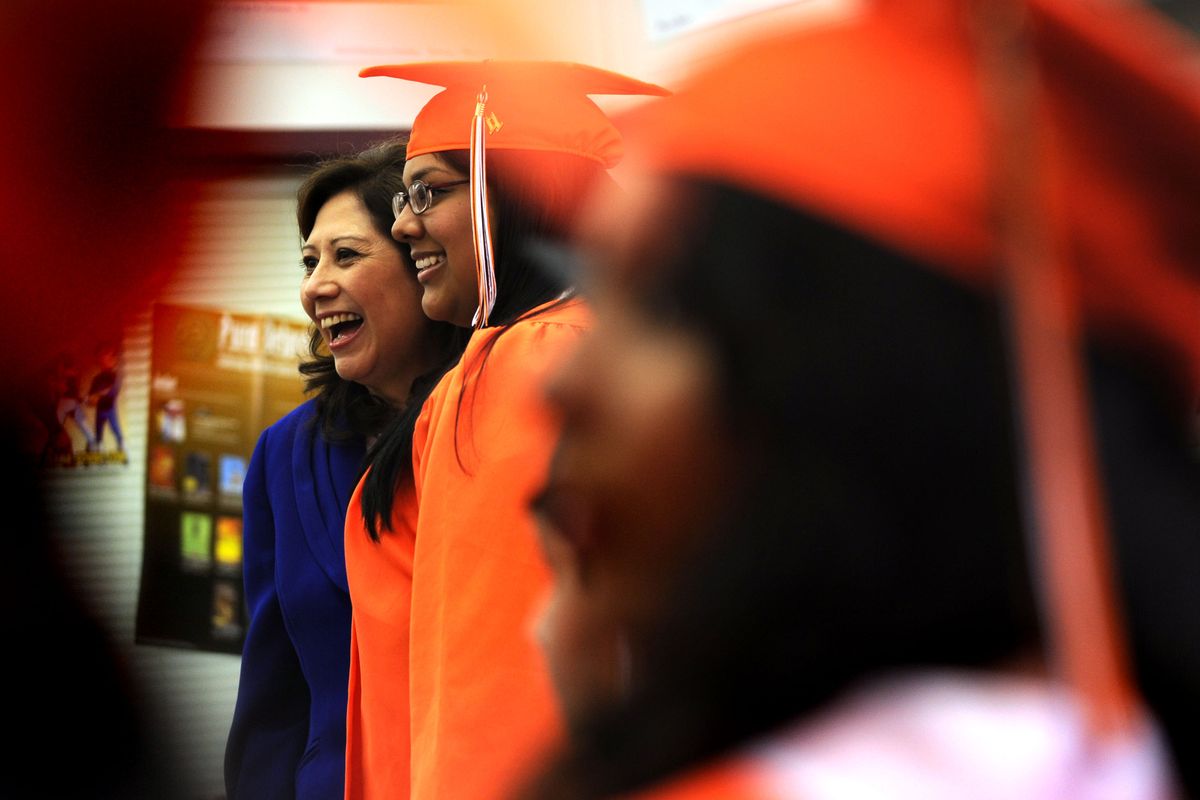Dedication to strong school system helps bring Bridgeport together

BRIDGEPORT, Wash. – Bridgeport, in rural north central Washington, is known regionally for its abundant apple and cherry orchards. Now the nation knows it for having a high school that’s transforming students.
Change is something the school district and the community have grappled with over the past two decades. The no-stoplight town has grown from a few hundred to more than 2,400 people, and demographics have shifted from 99 percent white to more than 76 percent Hispanic.
But residents’ solidarity has become evident as all cheered on the 95 percent Hispanic class of 2011, many of them first-generation high school students whose parents immigrated to America and settled in the area to work in agriculture.
All 37 seniors graduated Wednesday and have been accepted to a college.
“Quite frankly, what brought the community together are the schools. We got the kids involved,” said Steve Jenkins, former mayor of 23 years and a current Douglas County commissioner. “The district’s most recent (construction bond) passed by more than 70 percent, and that doesn’t happen unless the community believes in the schools.”
Bridgeport High School was one of three finalists in the nationwide Race to the Top Commencement Challenge, vying to bring President Barack Obama to speak at graduation. When he selected a school in Tennessee, the White House pledged to send a Cabinet member – Secretary of Labor Hilda Solis.
It was an accomplishment that brought out the community’s pride. But the town’s cohesiveness has been a work in progress for many years, Jenkins said.
“Small towns don’t deal with change easily,” he added.
Originally named Westfield, the community settled in the late 1800s and was incorporated in 1910. Its first big boom came with the construction of Chief Joseph Dam – the nation’s second-largest producer of hydropower – which began in 1949. But when construction ended in 1955, many of those who stayed went into agriculture – primarily fruit orchards.
Jean Hardie, the city administrator, is a third-generation Bridgeport resident. She grew up in the 1950s when the town was “a little Mayberry.”
“Kids ran the street. When it was time for dinner, moms would step out on the porch and yodel for the kids,” Hardie said. “Berryman Park was the main attraction.”
Her father worked for the public utilities district. Most of the people in town worked for the U.S. Army Corps of Engineers or in agriculture, she said. The town’s population then was in the low hundreds.
According the 2010 Census, Bridgeport’s Hispanic population has grown more than 38 percent in the past decade and the overall populace has grown by 17 percent.
Growth “has been driven by agriculture. I can’t even imagine how many acres have been added since the ’50s,” Hardie said. “With that, we needed workers to harvest. Workers had to be bused in and eventually moved here.”
Nearly 75 percent of Bridgeport’s residents work in agriculture – orchards and wheat, city officials say.
At first, Hardie said, “there were struggles to adapt to the diversity. When you are talking about a small community, they’re not the best at understanding different cultures. In a small town, you’re family, you know everyone and it takes time to get to know the newcomers. People were uncomfortable speaking with their neighbors because they spoke a different language. But we’ve adapted.”
Georgina Mogollan and her husband, Rogelio Roa, moved to Bridgeport in 1995 after emigrating from Pueblo, Mexico. Her youngest daughter, Jasmine, graduated from Bridgeport and has been accepted to Central Washington University.
“It was a better future, better job and you get more money,” said Mogollan, who went to school through the ninth grade and earned her GED not long ago. “Most important for me, their mother, … work in orchards is very hard and I no want this job for my children.”
Mogollan and Roa worked in the orchards for a “long, long time,” she said. But both now are employed by the school district.
Most of the graduating seniors have lived in Bridgeport their whole lives; some work in the orchards with their parents during the summer “to help support the family,” said Ana Soto, a graduating senior who will attend Whitworth University.
The students understand the challenges they’ve had to overcome and are proud of their town and accomplishments.
“We can achieve anything and motivate other high minority, high poverty agricultural rural schools to do the same,” a student wrote in an essay for the Race to the Top challenge. “BHS is welcoming and accepting of everyone regardless of age, race, socioeconomic standing or educational ability. If we could go to school anywhere, we would all choose to attend Bridgeport – we have everything we need here and a great education.”
Signs hanging around town congratulate the class of 2011, and business owners and local organizations have raised money for student scholarships.
“We tried a little harder this year to raise money because of all the great work by our seniors,” said Ken Krugel, who presented $6,000 in scholarships to the students.
One business owner in particular has made her pride for the students and the schools undeniably clear.
Nancine Lorz, co-owner of Nell’s Drive-In, in anticipation of President Barack Obama’s visit, had renamed her Hawaiian burger in his honor. But when he chose to speak in Memphis instead, she changed it back.
“You mess with our kids, you don’t get a burger named after you,” Lorz said.
Lorz also gave gifts to each of the seniors, she sponsored their senior picnic and 50 percent of the proceeds from a miniature golf course being installed on her property will go to the district.
“We don’t see color here,” said Lorz, who also considers her business the unofficial visitors bureau. “The kids are humble and hardworking. All the people at the school are great too. I’ve been down to the school and seen a janitor helping a kid with their homework.”